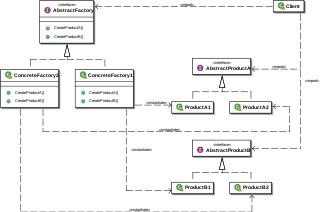
The abstract factory pattern in software engineering is a design pattern that provides a way to create families of related objects without imposing their concrete classes, by encapsulating a group of individual factories that have a common theme without specifying their concrete classes. According to this pattern, a client software component creates a concrete implementation of the abstract factory and then uses the generic interface of the factory to create the concrete objects that are part of the family. The client does not know which concrete objects it receives from each of these internal factories, as it uses only the generic interfaces of their products. This pattern separates the details of implementation of a set of objects from their general usage and relies on object composition, as object creation is implemented in methods exposed in the factory interface.
The bridge pattern is a design pattern used in software engineering that is meant to "decouple an abstraction from its implementation so that the two can vary independently", introduced by the Gang of Four. The bridge uses encapsulation, aggregation, and can use inheritance to separate responsibilities into different classes.

In computer programming, the flyweight software design pattern refers to an object that minimizes memory usage by sharing some of its data with other similar objects. The flyweight pattern is one of twenty-three well-known GoF design patterns. These patterns promote flexible object-oriented software design, which is easier to implement, change, test, and reuse.
In object oriented programming, the factory method pattern is a creational pattern that uses factory methods to deal with the problem of creating objects without having to specify their exact class. Rather than by calling a constructor, this is done by calling a factory method to create an object. Factory methods can either be specified in an interface and implemented by child classes, or implemented in a base class and optionally overridden by derived classes.
The prototype pattern is a creational design pattern in software development. It is used when the types of objects to create is determined by a prototypical instance, which is cloned to produce new objects. This pattern is used to avoid subclasses of an object creator in the client application, like the factory method pattern does, and to avoid the inherent cost of creating a new object in the standard way when it is prohibitively expensive for a given application.
In object-oriented programming, the decorator pattern is a design pattern that allows behavior to be added to an individual object, dynamically, without affecting the behavior of other instances of the same class. The decorator pattern is often useful for adhering to the Single Responsibility Principle, as it allows functionality to be divided between classes with unique areas of concern as well as to the Open-Closed Principle, by allowing the functionality of a class to be extended without being modified. Decorator use can be more efficient than subclassing, because an object's behavior can be augmented without defining an entirely new object.
In object-oriented programming, the command pattern is a behavioral design pattern in which an object is used to encapsulate all information needed to perform an action or trigger an event at a later time. This information includes the method name, the object that owns the method and values for the method parameters.
In object-oriented programming, the iterator pattern is a design pattern in which an iterator is used to traverse a container and access the container's elements. The iterator pattern decouples algorithms from containers; in some cases, algorithms are necessarily container-specific and thus cannot be decoupled.
In computer programming, the interpreter pattern is a design pattern that specifies how to evaluate sentences in a language. The basic idea is to have a class for each symbol in a specialized computer language. The syntax tree of a sentence in the language is an instance of the composite pattern and is used to evaluate (interpret) the sentence for a client. See also Composite pattern.
In software design and engineering, the observer pattern is a software design pattern in which an object, named the subject, maintains a list of its dependents, called observers, and notifies them automatically of any state changes, usually by calling one of their methods.
A method in object-oriented programming (OOP) is a procedure associated with an object, and generally also a message. An object consists of state data and behavior; these compose an interface, which specifies how the object may be used. A method is a behavior of an object parametrized by a user.
In object-oriented programming such as is often used in C++ and Object Pascal, a virtual function or virtual method is an inheritable and overridable function or method that is dispatched dynamically. Virtual functions are an important part of (runtime) polymorphism in object-oriented programming (OOP). They allow for the execution of target functions that were not precisely identified at compile time.
In computer programming, run-time type information or run-time type identification (RTTI) is a feature of some programming languages that exposes information about an object's data type at runtime. Run-time type information may be available for all types or only to types that explicitly have it. Run-time type information is a specialization of a more general concept called type introspection.
In computer science, object composition and object aggregation are closely related ways to combine objects or data types into more complex ones. In conversation the distinction between composition and aggregation is often ignored. Common kinds of compositions are objects used in object-oriented programming, tagged unions, sets, sequences, and various graph structures. Object compositions relate to, but are not the same as, data structures.
In computer programming, an opaque pointer is a special case of an opaque data type, a data type declared to be a pointer to a record or data structure of some unspecified type.
The curiously recurring template pattern (CRTP) is an idiom, originally in C++, in which a class X derives from a class template instantiation using X itself as a template argument. More generally it is known as F-bound polymorphism, and it is a form of F-bounded quantification.
C++11 is a version of the ISO/IEC 14882 standard for the C++ programming language. C++11 replaced the prior version of the C++ standard, called C++03, and was later replaced by C++14. The name follows the tradition of naming language versions by the publication year of the specification, though it was formerly named C++0x because it was expected to be published before 2010.
In object-oriented computer programming, a null object is an object with no referenced value or with defined neutral (null) behavior. The null object design pattern, which describes the uses of such objects and their behavior, was first published as "Void Value" and later in the Pattern Languages of Program Design book series as "Null Object".
In object-oriented design, the chain-of-responsibility pattern is a behavioral design pattern consisting of a source of command objects and a series of processing objects. Each processing object contains logic that defines the types of command objects that it can handle; the rest are passed to the next processing object in the chain. A mechanism also exists for adding new processing objects to the end of this chain.

Composition over inheritance in object-oriented programming (OOP) is the principle that classes should favor polymorphic behavior and code reuse by their composition over inheritance from a base or parent class. Ideally all reuse can be achieved by assembling existing components, but in practice inheritance is often needed to make new ones. Therefore inheritance and object composition typically work hand-in-hand, as discussed in the book Design Patterns (1994).






